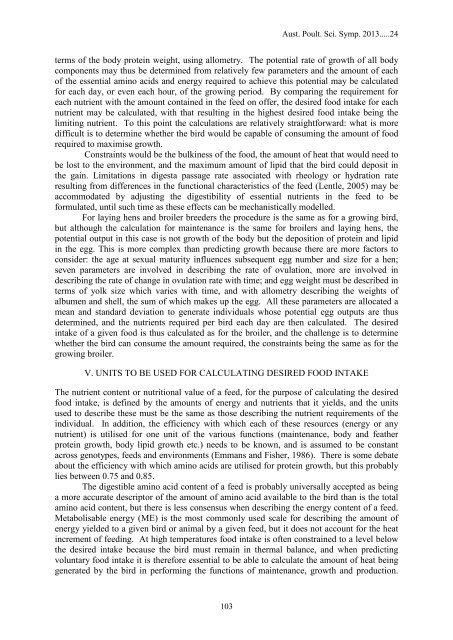APSS 2013 Proceedings - The University of Sydney
APSS 2013 Proceedings - The University of Sydney
APSS 2013 Proceedings - The University of Sydney
You also want an ePaper? Increase the reach of your titles
YUMPU automatically turns print PDFs into web optimized ePapers that Google loves.
Aust. Poult. Sci. Symp. <strong>2013</strong>.....24<br />
terms <strong>of</strong> the body protein weight, using allometry. <strong>The</strong> potential rate <strong>of</strong> growth <strong>of</strong> all body<br />
components may thus be determined from relatively few parameters and the amount <strong>of</strong> each<br />
<strong>of</strong> the essential amino acids and energy required to achieve this potential may be calculated<br />
for each day, or even each hour, <strong>of</strong> the growing period. By comparing the requirement for<br />
each nutrient with the amount contained in the feed on <strong>of</strong>fer, the desired food intake for each<br />
nutrient may be calculated, with that resulting in the highest desired food intake being the<br />
limiting nutrient. To this point the calculations are relatively straightforward: what is more<br />
difficult is to determine whether the bird would be capable <strong>of</strong> consuming the amount <strong>of</strong> food<br />
required to maximise growth.<br />
Constraints would be the bulkiness <strong>of</strong> the food, the amount <strong>of</strong> heat that would need to<br />
be lost to the environment, and the maximum amount <strong>of</strong> lipid that the bird could deposit in<br />
the gain. Limitations in digesta passage rate associated with rheology or hydration rate<br />
resulting from differences in the functional characteristics <strong>of</strong> the feed (Lentle, 2005) may be<br />
accommodated by adjusting the digestibility <strong>of</strong> essential nutrients in the feed to be<br />
formulated, until such time as these effects can be mechanistically modelled.<br />
For laying hens and broiler breeders the procedure is the same as for a growing bird,<br />
but although the calculation for maintenance is the same for broilers and laying hens, the<br />
potential output in this case is not growth <strong>of</strong> the body but the deposition <strong>of</strong> protein and lipid<br />
in the egg. This is more complex than predicting growth because there are more factors to<br />
consider: the age at sexual maturity influences subsequent egg number and size for a hen;<br />
seven parameters are involved in describing the rate <strong>of</strong> ovulation, more are involved in<br />
describing the rate <strong>of</strong> change in ovulation rate with time; and egg weight must be described in<br />
terms <strong>of</strong> yolk size which varies with time, and with allometry describing the weights <strong>of</strong><br />
albumen and shell, the sum <strong>of</strong> which makes up the egg. All these parameters are allocated a<br />
mean and standard deviation to generate individuals whose potential egg outputs are thus<br />
determined, and the nutrients required per bird each day are then calculated. <strong>The</strong> desired<br />
intake <strong>of</strong> a given food is thus calculated as for the broiler, and the challenge is to determine<br />
whether the bird can consume the amount required, the constraints being the same as for the<br />
growing broiler.<br />
V. UNITS TO BE USED FOR CALCULATING DESIRED FOOD INTAKE<br />
<strong>The</strong> nutrient content or nutritional value <strong>of</strong> a feed, for the purpose <strong>of</strong> calculating the desired<br />
food intake, is defined by the amounts <strong>of</strong> energy and nutrients that it yields, and the units<br />
used to describe these must be the same as those describing the nutrient requirements <strong>of</strong> the<br />
individual. In addition, the efficiency with which each <strong>of</strong> these resources (energy or any<br />
nutrient) is utilised for one unit <strong>of</strong> the various functions (maintenance, body and feather<br />
protein growth, body lipid growth etc.) needs to be known, and is assumed to be constant<br />
across genotypes, feeds and environments (Emmans and Fisher, 1986). <strong>The</strong>re is some debate<br />
about the efficiency with which amino acids are utilised for protein growth, but this probably<br />
lies between 0.75 and 0.85.<br />
<strong>The</strong> digestible amino acid content <strong>of</strong> a feed is probably universally accepted as being<br />
a more accurate descriptor <strong>of</strong> the amount <strong>of</strong> amino acid available to the bird than is the total<br />
amino acid content, but there is less consensus when describing the energy content <strong>of</strong> a feed.<br />
Metabolisable energy (ME) is the most commonly used scale for describing the amount <strong>of</strong><br />
energy yielded to a given bird or animal by a given feed, but it does not account for the heat<br />
increment <strong>of</strong> feeding. At high temperatures food intake is <strong>of</strong>ten constrained to a level below<br />
the desired intake because the bird must remain in thermal balance, and when predicting<br />
voluntary food intake it is therefore essential to be able to calculate the amount <strong>of</strong> heat being<br />
generated by the bird in performing the functions <strong>of</strong> maintenance, growth and production.<br />
103
















